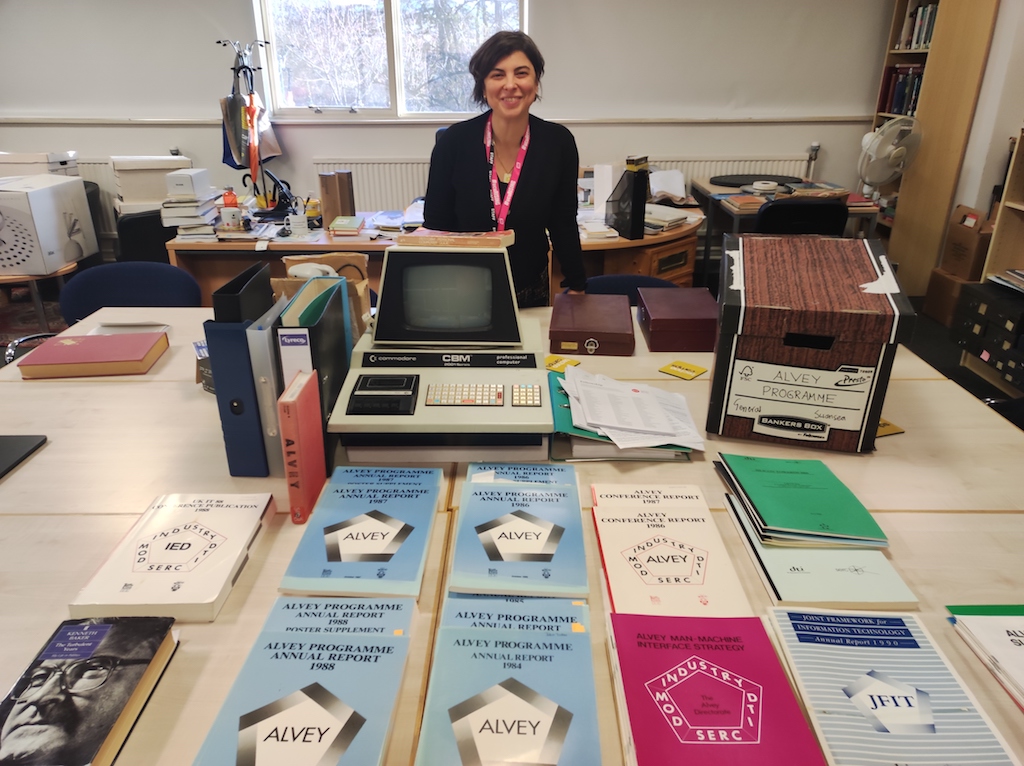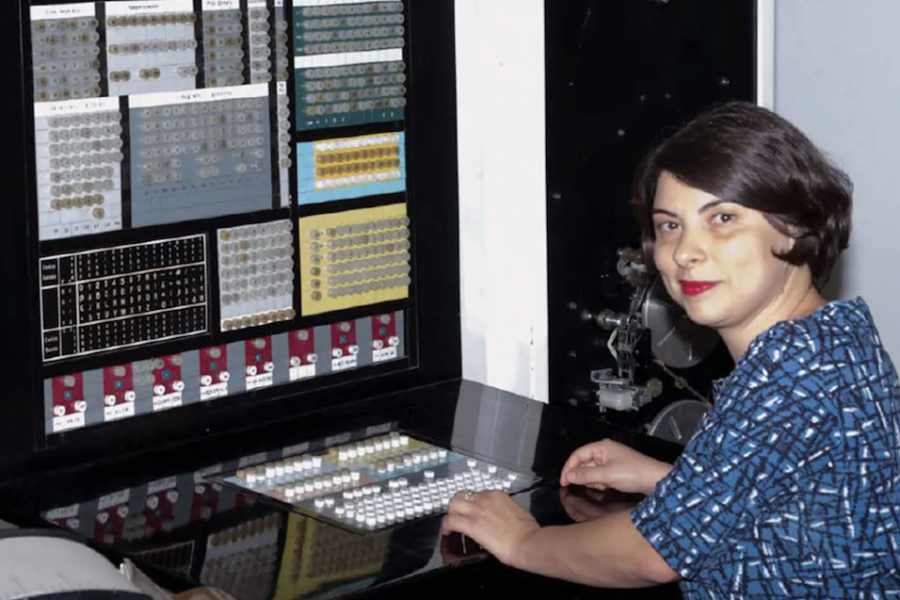Main image: Dr Elisabetta Mori with an Olvetti Elea 9003. Photograph by Armin Linke
Archives of IT (AIT) has commissioned Dr Elisabetta Mori to review our archival content and create new interviews to compile an in-depth written and video feature examining the development of human computer interaction over the past 70 years.
The working title of this project is: Human Computer Interaction in Britain and its impact on society (1950-2022) and has been made possible by a grant from The Worshipful Company of Information Technologists.
Dr Mori will use existing AIT content and conduct new interviews to bring together the story of human computer interaction (HCI) in a unique and comprehensive way.
Here AIT talks to Dr Mori about the project, who she’ll be interviewing, her involvement with AIT and how a series of events in her native Italy led to a passion for and career in computer research.
In 2009 Dr Elisabetta Mori had a life-changing moment when she encountered one of Italy’s and the world’s last working computers made in the late-1950s. It was a morning she would never forget and has since led to a career interviewing, researching and writing about computer history and the people behind it.
Born in Livorno, Italy in 1978 Dr Mori remembers being intrigued as a six-year-old by her father’s first computer, a VIC-20. A few years later in 1988 while at middle school she would attend experimental classes in the afternoon, which included lessons on Visual Communication and Computers.
“We had a Commodore 64 in the class and we would load a cassette, and from the time we pressed play to when we could use the computer, 20 minutes or more would pass. It meant the whole hour was made up of just 15 to 20 minutes’ practical lesson. However, it was still fascinating for me.”
Eureka moment
Dr Mori continued to be interested in computers; while studying architecture at the University of Florence practicing arts, in the early 2000s she used to attend Linux courses in the local hacklab. The hacklab itself was the place where she first encountered old computers and punch cards. In 2009 her eureka moment happened.
It came through an invitation to participate in an exhibition based on the theme: The Archives of Memory. The exhibition never happened, but she says it was destiny as the research for the exhibition led her to explore old computer memories, such as the core memory.
One of the main centres for early computers in Italy in the late 1950s was the University of Pisa, just 80km away; as part of her research Dr Mori visited the Museum of Computing Machinery of the University of Pisa where she saw her first mainframe, the Calcolatrice Elettronica Pisana or CEP, which had been developed by the University in the 1950s and presented to the public in 1961.
Olivetti Elea 9003
“This was something huge and completely fascinating to me; I remember spending this afternoon with the computer and discovering that at the same time there had been another project by the Olivetti company to make a commercial machine, that was serially produced. I learnt that the second machine of the series was still in existence and also working in a high school in Bibbiena, Tuscany. And that was the Olivetti Elea 9003.”
This particular Olivetti Elea 9003 was originally bought by the Monte dei Paschi di Siena bank, one of the oldest in the world, and later donated to a technical high school where it was neglected for decades before being restored by experts who had originally worked on the Olivetti computers.
“That was the encounter that changed my life. And I still remember this beautifully designed, noisy computer that was like a massive piece of furniture. The Olivetti architect, Ettore Sottsass, used to call it an ‘electronic landscape’.”
History of computers
A few years later in 2011 and 2012, she used this experience as inspiration for her master’s thesis: The History and Design of the First Commercial Italian Computer, designed by Olivetti and Ettore Sottsass Jr.
“This was something that completely defined my life because I spent months researching old computers and interviewing people, my first interviews go back to that time,” she says.
Dr Mori subsequently presented this research at an international conference on the History and Philosophy of Computing (HaPoC) in Paris in 2013 and began working in contemporary technology with smart textiles but I kept doing research in her spare time.
It was through this research that she was selected by the Association for Computing Machinery, the US-based international learned society for computing, to attend a workshop on Oral History of Computing at the University of North Carolina, in Chapel Hill, in 2016, where she was trained as an oral history interviewer.
Collaboration with AIT

This is where she first encountered AIT and was invited to collaborate as an interviewer two years later. Her first interview for AIT was with Louise Bennett in July 2018 and she has since completed about 30 in-depth interviews.
In 2016 Dr Mori was awarded a scholarship to work on the History and Philosophy of Computing in the Computer Science department, Middlesex University, London. She is most appreciative of the funding from the Association of Information Technology Trust. The LEO (Lyons Electronic Office) computers figured large in her research, thanks, she says, to “great support from the LEO Computers Society.”
She has published several academic papers and wrote an obituary for The Guardian when Peter Kirstein died in 2020 following her interview with him for AIT the previous year.
Now in 2023 she is embarking on her first writing commission for AIT, which will also encompass video interviews.
“This is something I have always wanted to research. It is linked to a special issue I edited for the IEEE Annals of the History of Computing entitled, Interface Architects: The Evolution of Human-Computer Interaction.
“What I noticed was there was more to be written and recorded about HCI in Britain for AIT and this project will involve researching within the archive and also expanding it by interviewing new people.”
Example of how the AIT archive can be used
The project will be an example of how people can use the AIT’s archives to conduct research and develop themes.
“The idea is to highlight important contributions to HCI that are covered in interviews in the archive and also to gather oral history from a selection of others who fill important gaps. I have already added a great conversation with Prof Linda Macaulay, Professor Emerita at the University of Manchester, who brings a very personal view of living and working with computers.
“I have a wish list of other interviewees and will fit in as many as I can. The idea is to have these people explain what has happened, their contribution to enhance the relationship between humans and computers, but also what happened to the discipline of HCI and to focus on the British highlights.”
Where necessary Dr Mori will draw on other sources, to include mention of important contributors to the field, such as Brian Shackel and his publications on ergonomics for computers.
Dr Mori says that when we talk about the interaction between humans and computers, HCI can be explored in two ways – one is the general relationship between humans and computers, e.g. from the first introduction of computers in business (e.g. the LEO computers), the other is the evolution of the HCI discipline, in the early 1980s.
“For example, an important chapter in UK computer history was the Alvey Programme and in particular what at the time was called ‘Man Machine Interface’ and to which there are numerous references in the archive; we are going to talk about this British Government sponsored research from 1983-1987. “
The AIT archives include accounts of a huge diversity of HCI technologies, which will be explored as part of the project. These include Prof Kevin Warwick talking about his ground-breaking experiments of connecting computing devices directly into the human nervous system and brain, Robin Christopherson offering a fascinating insight into assistive technology, both as a computer scientist and a blind person and Cyril Hilsum’s work on Liquid Crystal Displays (LCD) transformed (probably) the most common form of computer output device.
While AIT is UK centric, we are also fortunate to have inputs from some international figures, such as Dr A Michael Noll, who created an early haptic device 50 years ago and Prof Mischa Dohler who reflected about how 6G will enable global, interactive working and artistic performance.
The interviews and research are now underway and will continue throughout January and February with publication in spring 2023.
